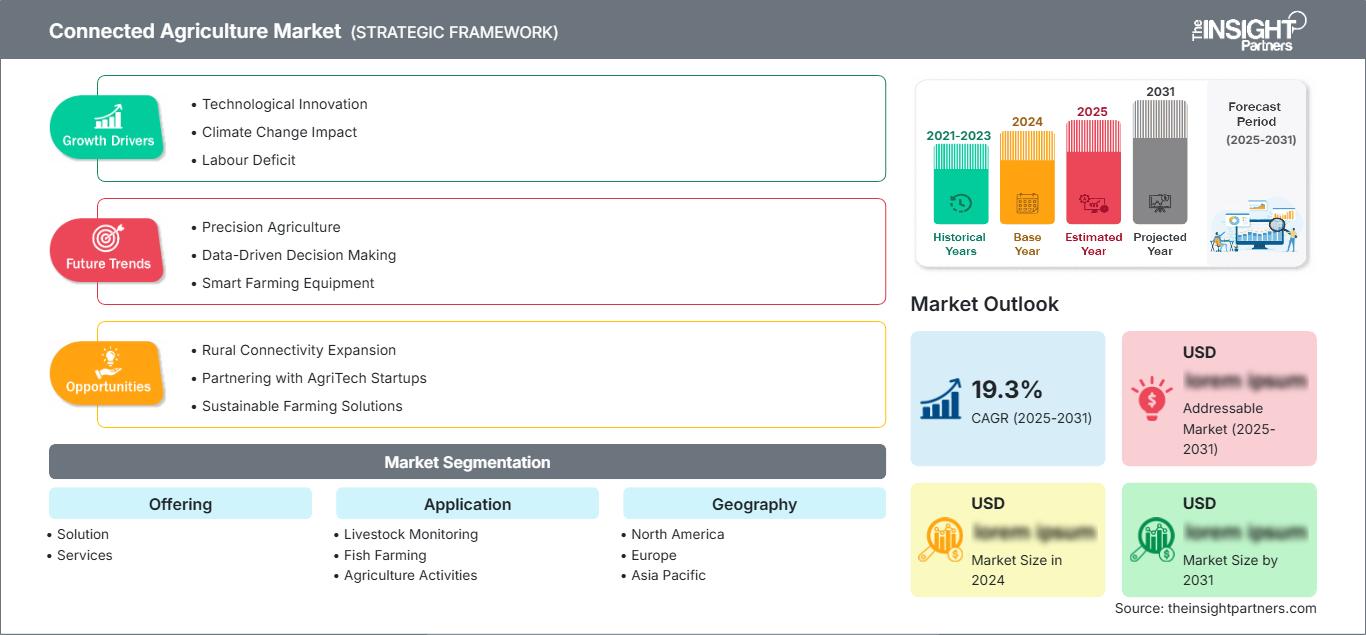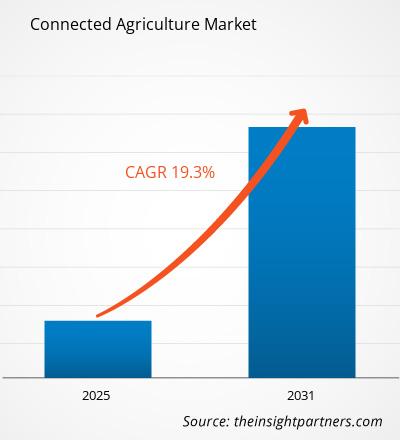页面已更新 :
Jan 2025
预计 2025 年至 2031 年互联农业市场的复合年增长率为 19.3%,市场规模将从 2024 年的 XX 百万美元扩大到 2031 年的 XX 百万美元。
该报告按产品(解决方案、服务)细分;应用(牲畜监测、鱼类养殖、农业活动、智能温室、农场劳动力管理、其他)。全球分析进一步细分为区域和主要国家。该报告以美元提供上述分析和细分的价值。
报告目的
Insight Partners 撰写的《互联农业市场》报告旨在描述当前形势和未来增长、主要驱动因素、挑战和机遇。这将为各种业务利益相关者提供见解,例如:
- 技术提供商/制造商:了解不断变化的市场动态并了解潜在的增长机会,使他们能够做出明智的战略决策。
- 投资者:对市场增长率、市场财务预测和整个价值链中存在的机会进行全面的趋势分析。
- 监管机构:规范市场政策和警察活动,旨在最大限度地减少滥用,维护投资者的信任和信心,并维护市场的完整性和稳定性。
互联农业市场细分产品
- 解决方案
- 服务
应用程序
- 牲畜监控
- 鱼类养殖
- 农业活动
- 智能温室
- 农场劳动力管理
- 其他
自定义此报告以满足您的要求
您将免费获得任何报告的定制,包括本报告的部分内容,或国家级分析、Excel 数据包,以及为初创企业和大学提供超值优惠和折扣
互联农业市场: 战略洞察

- 获取本报告的主要市场趋势。这个免费样本将包括数据分析,从市场趋势到估计和预测。
互联农业市场增长动力
- 对提高农业生产力的需求日益增长:随着全球人口的增长,对粮食生产的需求也随之增长。互联农业解决方案可以优化耕作流程,提高作物产量,并最大限度地提高效率,以满足日益增长的粮食需求。由于城市地区的扩张以及不可持续的耕作方式导致的耕地退化,充分利用现有农田的压力日益增大。
- 农业自动化和机器人技术:机器人和自动驾驶汽车(例如拖拉机、收割机和无人机)正在改变农业,因为它们使劳动密集型作业实现了自动化。这减少了对人工的依赖,提高了效率,并降低了运营成本。配备传感器和 GPS 技术的自动化设备可帮助农民精确管理种植、灌溉、施肥和收割,从而提高产量一致性并降低投入成本。
互联农业市场未来趋势
- 物联网和互联技术的进步:农民现在可以借助物联网 (IoT) 技术,通过传感器、无人机和自动化机械实时监测和管理田地和作物。基于物联网的解决方案收集土壤湿度、温度、作物健康和环境因素相关数据,帮助农民做出数据驱动的决策。
- 智能农业设备和自动驾驶汽车的兴起:互联农业市场正见证着智能农业设备和自动驾驶汽车的使用趋势日益增长。配备传感器和 GPS 技术的拖拉机、收割机和无人机正变得越来越自主,使农民能够在最少的人为干预下完成种植、喷洒和收割等任务。这些机器可以全天候运行,显著提高效率并降低劳动力成本。受提高生产力和减少资源消耗需求的推动,农业自动化趋势预计将加速互联农业技术的普及。
互联农业市场机遇
- 可持续性和资源效率:互联农业帮助农民减少浪费,节约资源。精准农业技术,例如变量灌溉、作物轮作计划和智能农药管理,可以帮助农民减少水和能源消耗,同时最大限度地减少农业对环境的负面影响。高效利用水资源正变得越来越重要,尤其是在面临干旱和水资源短缺的地区。物联网传感器和智能灌溉系统确保高效利用水资源,从而避免浪费,并确保作物在合适的时间获得合适的水。
- 面向小农户的农业技术解决方案的扩展:小农户,尤其是新兴市场的小农户,为互联农业解决方案带来了巨大的机遇。这些农民通常缺乏先进的农业技术、数据和资金。通过提供价格实惠、可扩展且易于使用的技术,互联农业公司可以帮助小农户提高作物产量、减少损失并更有效地进入市场。根据小农户的需求量身定制的移动平台和低成本物联网传感器是推动互联农业在农村地区应用的关键机遇,有助于提高农业生产力并促进经济增长。
互联农业市场区域洞察
The Insight Partners 的分析师已详尽阐述了预测期内影响互联农业市场的区域趋势和因素。本节还讨论了北美、欧洲、亚太地区、中东和非洲以及南美和中美洲的互联农业市场细分和地域分布。
互联农业市场报告范围
| 报告属性 | 细节 |
|---|---|
| 市场规模 2024 | US$ XX million |
| 市场规模 2031 | US$ XX Million |
| 全球复合年增长率 (2025 - 2031) | 19.3% |
| 历史数据 | 2021-2023 |
| 预测期 | 2025-2031 |
| 涵盖的领域 |
By 产品
|
| 覆盖地区和国家 | 北美
|
| 市场领导者和主要公司简介 |
|
互联农业市场参与者密度:了解其对商业动态的影响
互联农业市场正在快速增长,这得益于终端用户需求的不断增长,而这些需求的驱动因素包括消费者偏好的演变、技术进步以及对产品优势的认知度的提升。随着需求的增长,企业正在扩展产品线,不断创新以满足消费者需求,并抓住新兴趋势,从而进一步推动市场增长。

- 获取 互联农业市场 主要参与者概述
主要卖点
- 全面覆盖:该报告全面涵盖了对互联农业市场的产品、服务、类型和最终用户的分析,提供了整体格局。
- 专家分析:该报告基于对行业专家和分析师的深入了解而编写。
- 最新信息:该报告涵盖了最新信息和数据趋势,确保了业务相关性。
- 定制选项:此报告可以根据特定客户要求进行定制,并适合业务策略。
因此,互联农业市场研究报告可以帮助引领解码和理解行业情景和增长前景的道路。尽管可能存在一些合理的担忧,但本报告的总体优势往往大于劣势。
- 历史分析(2 年)、基准年、预测(7 年)及复合年增长率
- PEST和SWOT分析
- 市场规模、价值/数量 - 全球、区域、国家
- 行业和竞争格局
- Excel 数据集
近期报告
客户评价
购买理由
- 明智的决策
- 了解市场动态
- 竞争分析
- 客户洞察
- 市场预测
- 风险规避
- 战略规划
- 投资论证
- 识别新兴市场
- 优化营销策略
- 提升运营效率
- 顺应监管趋势
我们的客户































87-673-9708

ISO 9001:2015



 获取免费样品 - 互联农业市场
获取免费样品 - 互联农业市场